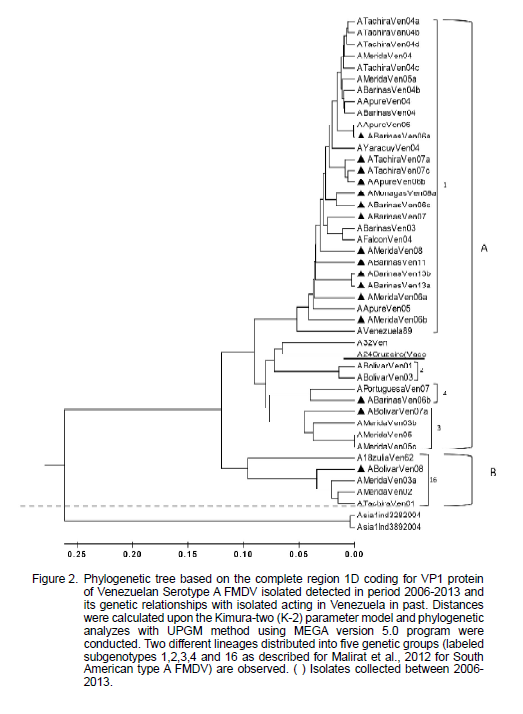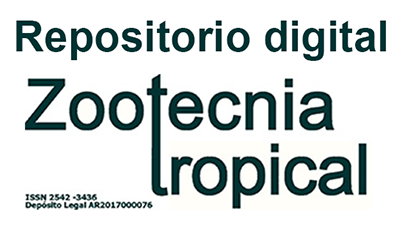Diversidad genética del virus de la fiebre aftosa serotipo A en Venezuela (2001-2013)
Resumen
Venezuela es el único país suramericano con circulación endémica del virus de la Fiebre Aftosa (VFA) en todo su territorio. Se utilizó filogenia molecular (secuencias nucleotídicas del gen 1D-Vp1) para caracterizar los VFA serotipo A activos entre 2006-2013 (16 cepas). El análisis filogenético incluyó además 23 cepas aisladas (2001-2007) y 3 cepas de relevancia histórica en al país. Considerando el periodo (2001-2013), se observa una extensa diversidad genética reflejada en: a) coexistencia de cinco grupos genéticos (denominados subgenotipos 1,2,3,4 y 16 acorde a clasificación del serotipo A de Suramérica), distribuidos en dos linajes genéticos diferentes denominados A y B (divergencia genética>20%), b) incremento en la diversificación del grupo genético más prevalente (subgenotipo 1) y c) persistencia de un grupo filogenéticamente distante de la cepa vacunal (subgenotipo 16). Al analizar las cepas de este estudio (2006-2013), se encontró que el subgenotipo 1 (más prevalente), muestra mayor heterogeneidad genética respecto a 2001-2006 y se re-detecta un aislado filogenéticamente distante de la cepa vacunal, que coinciden con la mayor incidencia de FA en Venezuela (2006-2008). Esta mayor diversificación está relacionada con la presión inmunológica de selección (positiva) ejercida por la vacunación (selección de nuevas variantes de menor homología a la vacuna), por tanto, resalta la necesidad de mejorar la efectividad de las campañas de vacunación y la atención de focos. Este estudio describe los virus activos del periodo más reciente (2006-2013) en el país y se complementa el banco de datos de secuencias 1D-Vp1 del VFA tipo A de Venezuela (45 cepas 2001-2013).
Descargas
Citas
• Carrillo, C., E. Tulman, G. Delhon, Z. Lu, A. K. Vagnozzi and D. Rock. 2005. Comparative genomics of foot-and-mouth disease virus. Journal of Virology. 79(10):6487-6504.
• Castro J. 2005. Enfermedades Vesiculares. Available on line: http://www.avpa.ula.ve/docuPDFs/libros_online/manual-ganaderia/seccion5/articulo12-s5.pdf [Dic.19, 2013].
• Clavijo, A., P. Vieira-Pereira and I. E. Bergmann. 2003. Use of the reverse transcription polymerase chain reaction (RT-PCR) for the rapid diagnosis of foot and mouth disease in South America. Veterinary Research Communications. 27:63-71.
• Cowan, K. M., N. Errol and A. P. Whitehead. 1974. Heterogeneity of type Asia 1 foot-and-mouth disease virus in BHK-1 cells and relationship to vaccine preparation. Bulletin - Office International Des Epizooties.81:1271-1298.
• Domingo, E., C. Escarmıs, E. Baranowski, C.Ruiz-Jarabo, E. Carrillo, J. I. Nuñez and F. Sobrino. 2003. Evolution of foot-and-mouth disease virus. Review. Virus Research. 91:47-63.
• Grubman, M. and B. Baxt. 2004. Foot-and-mouth disease. Clinical Microbiology Reviews.17(2):465-493.
• Haydon, D., A. R. Samuel and N. J. Knowles. 2001. The generation and persistence of genetic variation in foot-and-mouth disease virus. Preventive Veterinary Medicine. 51:111-124.
• Hall, T. A. 1999. BioEdit: a user-friendly biological sequence alignment editor and analysis program for Windows 95/98/NT. Nucleic Acids Symposium Series. 41:95-98.
• Jackson, A., H. O’Neill, F. Maree, B. Blignaut, C. Carrillo, L. Rodríguez and D. T. Haydon. 2007. Mosaic structure of foot-and-mouth disease virus genomes. Journal of General Virology. 88:487-492.
• Klein, J., M. Hussain, M. Ahmad, P. Normann, M. Afzal and S. Alexandersen. 2007. Genetic characterization of the recent foot-and-mouth disease virus subtype A/IRN/2005. Virology Journal. 4:122.
• Knowles, N. and A. Samuel. 1998. RT-PCR and sequencing PROTOCOL WRL-FMD: Molecular epidemiology OIE/FAO World Reference Laboratory for Foot-and-Mouth Disease. Institute for Animal Health, Pirbright Laboratory. United Kingdom. Available on line: http://www.wrlfmd.org/fmd_genotyping/genotyping_protocol.pdf [Sep. 19, 2013].
• Knowles, N. and A. Samuel. 2003. Molecular epidemiology of foot-and-mouth disease virus. Virus Research. 91(1):65-80.
• König, G. A., E. L. Palma, E. Maradei and M. E. Piccone. (2007). Molecular epidemiology of foot-and-mouth disease virus types A and O isolated in Argentina during the 2000-2002 epizootic. Veterinary Microbiology.124(1-2):1-15
• Malirat, V. e I. Bergman. 2003. Fiebre Aftosa - Instrumentos moleculares para caracterización viral. Manual RT-PCR y secuenciamiento cíclico para estudios de epidemiología molecular del virus de la Fiebre Aftosa. Serie de manuales didácticos No. 17. Rio de Janeiro, Brasil. Available on line: http://bvs.per.paho.org/texcom/cd048213/fiebrebaftosa.pdf [Dic. 15, 2012].
• Malirat, V., I. Bergmann, R. de Mendonca- Campos, E. Neitzert, M. Villamil, J. Quiroga-Civera, F. Conde and G. Salgado. 2008. Tracing 2007-2008 emergency episodes of foot-and-mouth disease virus in South America: phylogenetic analysis. Proceedings of The Global control of FMD - Tools, ideas and ideals. 14-17 October 2008. Erice, Italy. Appendix 58. 329 p.
• Malirat, V., I. Bergmann, R. de Mendonca- Campos, F. Conde, J. Quiroga, M. Villamil, G. Salgado and S. Ortiz. 2012. Molecular epidemiology of foot-and-mouth disease virus type A in South America. Veterinary Microbiology. 158:82-94. [May. 14, 2013].
• McCahon, D. 1981.The genetics of aphthovirus. Archives Virology. 69:1-23.
• Mohapatra, J., S. Subramaniam, K. L. Pandey, S. Pawar, A. D. Biswajit-Das, A. Sanyal and B. Pattnaik. 2011. Phylogenetic structure of serotype A foot-and-mouth disease virus: global diversity and the Indian perspective. Journal of General Virology. 92:873-879. OIE (World Organization for Animal Health). 2012. Foot and mouth disease (infection with foot and mouth disease virus). Chapter 2.1.5. Available on line: http://bit.ly/2tfy3Nd [Ago. 15, 2014].
• PANAFTOSA. 2016. Informe de situación de los programas de erradicación de la fiebre aftosa en Sudamérica y Panamá en 2016. Disponible en línea: http://bit.ly/2uNjzVz [Ago. 01, 2016].
• Paton, D. J., J. F. Valarcher, I. Bergmann, O. G. Matlho, V. M. Zakharov, E. L. Palma and G. R. Thomson. 2005. Selection of foot and mouth disease vaccine strains - a review. Rev. Sci. Tech. Off. Int. Epiz. 24(3):981-993.
• Piñate, P. 2000. De la lucha contra la fiebre aftosa en el mundo, Venezuela y Sudamérica. Disponible en línea: http://bvs.panaftosa.org.br/textoc/FMD%20AMERICAS(P.Pi%F1ade.pdf). [Sep. 25, 2013].
• Samuel, A. and N. Knowles. 2001. Foot-and-mouth disease type O viruses exhibit genetically and geographically distinct evolutionary lineages (topotypes). Journal of General Virology. 82:609-621.
• Tosh, C., D. Hemadri, A. Sanyal. 2002a. Evidence of recombination in the capsid coding region of type A foot-and-mouth disease virus. Journal of General Virology.83:2455-2460.
• Tosh, C., A. Sanyal, D. Hemadri, R. Venkataramanan. 2002b. Phylogenetic analysis of serotype A foot-and-mouth disease virus isolated in India between 1977 and 2000. Archives of Virology. 147:493-513.
• Tully, D. and M. Fares. 2009. Shifts in the selection-drift balance drive the evolution and epidemiology of foot-and-mouth disease virus. Journal of Virology. 83(2):781- 790.

Derechos de autor 2016 Chrístel C. Machín Pire, Gladys M. Medina Gutiérrez, Carmen G. Pérez, José A. López Ramón

Esta obra está bajo licencia internacional Creative Commons Reconocimiento-NoComercial-CompartirIgual 4.0.








